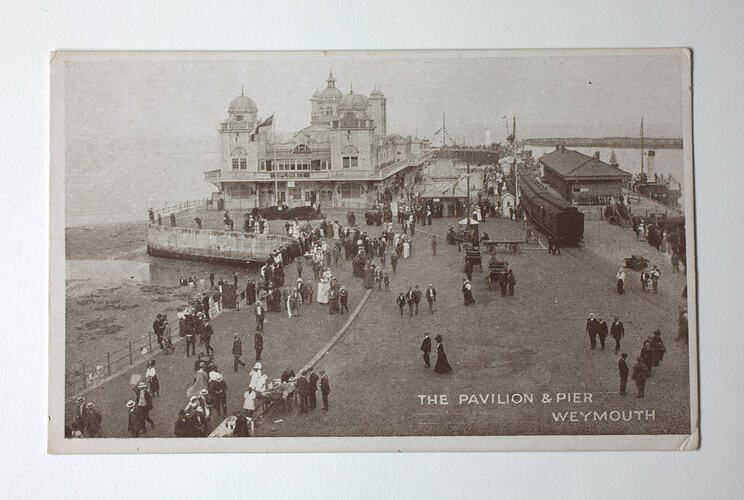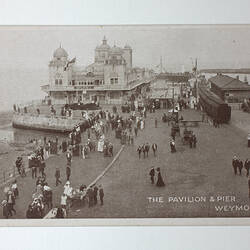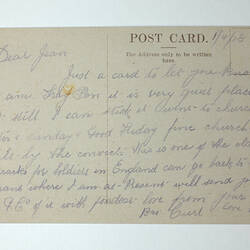Summary
Black and white photograph of the pavilion and pier at Weymouth in Dorset, England. Part of a collection of material relating to the World War I service of brothers John and Albert Victor Peile. The postcard is signed by 'Curl.' 'Curl' seems to be a reference to John Peile as the return address listed on ST 40698 has his name and regiment.
The pavilion (later known as the 'Ritz') at Weymouth, opened in 1908 but burned down in 1954. A replacement pavilion was built on the site in 1960.
Weymouth itself opened as a depot for wounded ANZAC soldiers in May 1915 and originally catered for casualties from Gallipoli. Weymouth later became A.I.F. Command Depot No.2. No. 2 C.D. and most of the A.I.F. servicemen who were no longer fit for service and repatriated to Australia would have passed through the town. Montevideo was the principle Australian camp near Weymouth, named for Montevideo House that now serves as a nursing home.
In June 2005 a memorial was erected in Weymouth to the ANZAC soldiers who stayed in the area, some of whom are buried nearby at the Weymouth and Melcome Regis Cemetery.
Part of a collection of material relating to the World War I service of brothers John and Albert Victor Peile, who both died in the conflict. Younger brother Albert enlisted first. He was a 22-year-old unmarried clerk when he enlisted on 27 August 1914, service number 769, 3rd Battalion. He served in Gallipoli and later France, and was eventually promoted to the rank of corporal. He died in Bullecourt, France on 4 May 1917; his body was never found. He is commemorated at the Villers-Bretonneux Memorial. His brother John Peile was a 38-year-old unmarried miner when he enlisted on 25 June 1915, service number 2662, 2nd Battalion. He also served in in Gallipoli and France, and was similarly promoted to corporal. He died in France on 18 September 1918 and is buried at Roisel Communal Cemetery Extension, France. Their mother died only a few years later in 1926, aged 73.
Their niece was Mrs M. J. Hitchens, the donor. Margaret Joan Hitchens (1916-?) was the daughter of Albert and John's sister Alice and her husband John Henry Dinwoodie.
Description of Content
Pier with large building topped with cuploas, and pedestrians around.
Physical Description
Black and white photograph printed on paper.
More Information
-
Collection Names
-
Collecting Areas
-
Acquisition Information
Donation from Victorian Branch, Returned & Services League of Australia Limited (RSL), Mrs Margaret J. Hitchens, 1986
-
Author
Corporal John '. Peile - Australian Imperial Force (AIF), 1 Apr 1918
-
Place Depicted
-
Inscriptions
Printed on front: 'PAVILION & PIER / WEYMOUTH' Printed on back: 'POST CARD. / The Address to be written here' Handwritten on back: '1/4/18 / Dear Jean / Just a card to let you know / I am Trag(?) Don it is very quiet place / but still I can stick it went to church / Easter Sunday & Good Friday fine church. / built by the convicts this is one of the oldest / Barracks for Soldiers in England can go back to the / Normans where I am at Present will send you / some PCs of it with fondest love from your / Bro Curl love to all' Printed vertically on back left: 'Published by the Australian Y.M.C.A.'
-
Classification
-
Category
-
Discipline
-
Type of item
-
References
Department of Veterans Affairs, 'The ANZAC Memorial,' Overseas Monuments, at: [Link 1] accessed: June 18, 2012 'Weymouth, Dorset, England,' History and Heritage of Weymouth and Dorset Area, at: [Link 2] accessed: June 18, 2012 For Albert Peile's war record see the National Archives of Australia website at: [Link 3] For John Peile's war record see the National Archive of Australia website at: [Link 4]
-
Keywords


